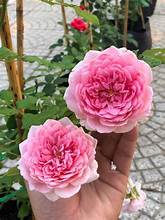Pompadour Roses and Ikebana Art: Style and Meaning

In this article, we delve into the exquisite world of Pompadour roses and the ancient Japanese art of Ikebana, exploring the unique style, cultural significance, and symbolic meanings associated with the harmonious fusion of these two floral traditions.
#### Understanding Ikebana Art
1. **Origins and Philosophy**
– Ikebana, also known as Kado or the “way of flowers,” is a traditional Japanese art form that dates back centuries. Originating from Buddhist rituals and Shinto ceremonies, Ikebana emphasizes simplicity, balance, and harmony in floral arrangements.
– Unlike conventional Western floral arrangements, which focus primarily on aesthetics, Ikebana seeks to capture the essence of nature and evoke spiritual insights through the arrangement of flowers, branches, and leaves.
2. **Principles and Techniques**
– Ikebana follows fundamental principles such as asymmetry, minimalism, and negative space to create compositions that reflect the beauty of impermanence and the transience of life. Ikebana artists use precise techniques, including line, mass, and form, to express subtle emotions and evoke contemplative responses.
– Each Ikebana arrangement is meticulously crafted to evoke a specific mood or theme, drawing inspiration from seasonal changes, natural landscapes, and cultural symbolism. Ikebana artists often incorporate symbolic elements such as color, texture, and placement to convey deeper meanings and evoke emotional resonance.
#### Pompadour Roses in Ikebana
1. **Elegance and Sophistication**
– Pompadour roses, with their lush petals, delicate fragrance, and graceful form, epitomize elegance and sophistication in Ikebana arrangements. The soft pastel hues and intricate textures of Pompadour roses complement the refined aesthetic of Ikebana, adding a touch of romance and charm to floral compositions.
– Ikebana artists appreciate the versatility of Pompadour roses, which can serve as focal points, accents, or structural elements in Ikebana arrangements. Whether showcased singly or combined with other botanical materials, Pompadour roses bring timeless beauty and timeless beauty to Ikebana creations.
2. **Symbolism and Meaning**
– In Ikebana, Pompadour roses carry rich symbolic meanings that resonate with Japanese cultural values and aesthetic sensibilities. The graceful curves and gentle folds of Pompadour rose petals symbolize beauty, grace, and refinement, while their subtle fragrance evokes feelings of serenity and tranquility.
– Depending on the context and arrangement, Pompadour roses can convey various sentiments and themes in Ikebana, from love and romance to purity and reverence. Ikebana artists often imbue their creations with personal interpretations and philosophical insights, inviting viewers to contemplate the deeper significance of each floral composition.
#### Styles of Ikebana Arrangements
1. **Moribana**
– Moribana, or “piled-up flowers,” is a popular style of Ikebana characterized by low, shallow containers and a naturalistic approach to arrangement. Pompadour roses are often featured prominently in Moribana arrangements, nestled among complementary botanical materials such as branches, leaves, and grasses.
– Moribana arrangements highlight the inherent beauty of Pompadour roses while celebrating the harmony between contrasting elements and textures. The juxtaposition of soft floral blooms against rugged branches and foliage creates dynamic compositions that evoke the vitality of nature.
2. **Rikka**
– Rikka, or “standing flowers,” is a traditional form of Ikebana that emphasizes verticality, symmetry, and structural balance. Pompadour roses can be integrated into Rikka arrangements as focal points or accent elements, adding depth and dimension to the overall composition.
– In Rikka arrangements, Pompadour roses symbolize elegance and refinement, serving as focal points around which other botanical materials are arranged in precise geometric patterns. The graceful curves and intricate details of Pompadour roses enhance the aesthetic appeal of Rikka compositions, infusing them with a sense of grace and harmony.
#### Conclusion
Pompadour roses and Ikebana art represent a harmonious fusion of natural beauty, cultural heritage, and artistic expression. By combining the timeless elegance of Pompadour roses with the refined aesthetics of Ikebana, artists create floral masterpieces that evoke emotions, inspire contemplation, and celebrate the inherent beauty of the natural world.
### Pompadour Roses and Ikebana Art: Style and Meaning (Part 2)
Continuing our exploration of the captivating synergy between Pompadour roses and the elegant art of Ikebana, we delve deeper into the diverse styles, creative techniques, and profound symbolism associated with incorporating Pompadour roses into Ikebana arrangements.
#### Creative Techniques in Ikebana Artistry
1. **Sogetsu School**
– The Sogetsu School of Ikebana emphasizes creativity, innovation, and individual expression, offering practitioners the freedom to explore unconventional materials and design concepts. Pompadour roses are often featured prominently in Sogetsu-style arrangements, where they serve as focal points or sculptural elements amidst a backdrop of natural or man-made materials.
– Sogetsu artists employ a wide range of techniques, including bending, folding, and weaving, to manipulate Pompadour roses and other botanical elements into dynamic compositions that reflect the beauty of impermanence and the resilience of nature.
2. **Ikenobo School**
– The Ikenobo School of Ikebana, founded in the 15th century, is one of the oldest and most traditional schools of Ikebana. Ikenobo-style arrangements emphasize simplicity, balance, and harmony, drawing inspiration from natural landscapes and seasonal motifs. Pompadour roses are often incorporated into Ikenobo arrangements to evoke feelings of serenity, elegance, and reverence.
– Ikenobo artists use precise techniques, such as kubari (branch manipulation) and moribana (piled-up flowers), to create harmonious compositions that reflect the essence of Japanese aesthetics and cultural traditions. Pompadour roses add a touch of sophistication and refinement to Ikenobo-style arrangements, enhancing their visual appeal and symbolic depth.
#### Symbolism in Ikebana Arrangements
1. **Ma: Embracing the Beauty of Negative Space**
– In Ikebana, the concept of “ma” refers to the beauty of negative space or the empty void between elements. Pompadour roses are often arranged in Ikebana compositions to create a sense of balance and harmony within the spatial context, allowing for contemplative reflection and visual resonance.
– By strategically incorporating Pompadour roses into Ikebana arrangements, artists can evoke a sense of tranquility, simplicity, and mindfulness, inviting viewers to appreciate the beauty of silence and stillness in a fast-paced world.
2. **Wabi-Sabi: Finding Beauty in Imperfection**
– Wabi-sabi is a Japanese aesthetic philosophy that celebrates the beauty of imperfection, impermanence, and the patina of age. Pompadour roses, with their delicate petals and ephemeral beauty, embody the principles of wabi-sabi in Ikebana arrangements, where they symbolize the transient nature of life and the fleeting beauty of the natural world.
– Ikebana artists often embrace imperfections in Pompadour roses, such as asymmetrical blooms or irregular petal shapes, as expressions of authenticity and uniqueness. By highlighting the inherent imperfections of Pompadour roses in their arrangements, artists evoke a sense of authenticity, humility, and appreciation for the fleeting moments of beauty in life.
#### Contemporary Trends and Innovations
1. **Minimalism and Simplicity**
– Contemporary Ikebana artists often explore minimalist aesthetics and simplicity in their floral compositions, using Pompadour roses sparingly to create elegant yet understated arrangements. By emphasizing negative space and clean lines, contemporary Ikebana designs with Pompadour roses evoke a sense of serenity, sophistication, and modernity.
– Pompadour roses are arranged with precision and restraint, allowing their inherent beauty to shine through without overwhelming the composition. Contemporary Ikebana with Pompadour roses reflects a fusion of traditional craftsmanship and contemporary sensibilities, appealing to a new generation of floral enthusiasts and design aficionados.
2. **Experimental Materials and Techniques**
– As Ikebana evolves with the times, artists are increasingly experimenting with unconventional materials and techniques to push the boundaries of traditional floral design. Pompadour roses are paired with unexpected elements such as metal wire, recycled materials, or digital projections to create avant-garde Ikebana installations that challenge perceptions and provoke thought.
– By incorporating Pompadour roses into experimental Ikebana compositions, artists explore new avenues of creativity, innovation, and self-expression, redefining the boundaries of floral art and expanding the possibilities of Ikebana as a contemporary art form.
#### Conclusion
Pompadour roses and Ikebana artistry represent a timeless fusion of natural beauty, cultural heritage, and artistic expression. By integrating Pompadour roses into Ikebana arrangements, artists evoke emotions, provoke contemplation, and celebrate the enduring allure of nature’s bounty.
Incorporating Pompadour roses into Ikebana compositions offers endless opportunities for creative expression, cultural exchange, and personal growth. Whether adhering to traditional principles or embracing contemporary trends, Ikebana artists continue to find inspiration in the delicate petals and graceful forms of Pompadour roses, creating floral masterpieces that captivate the senses and nourish the soul.

